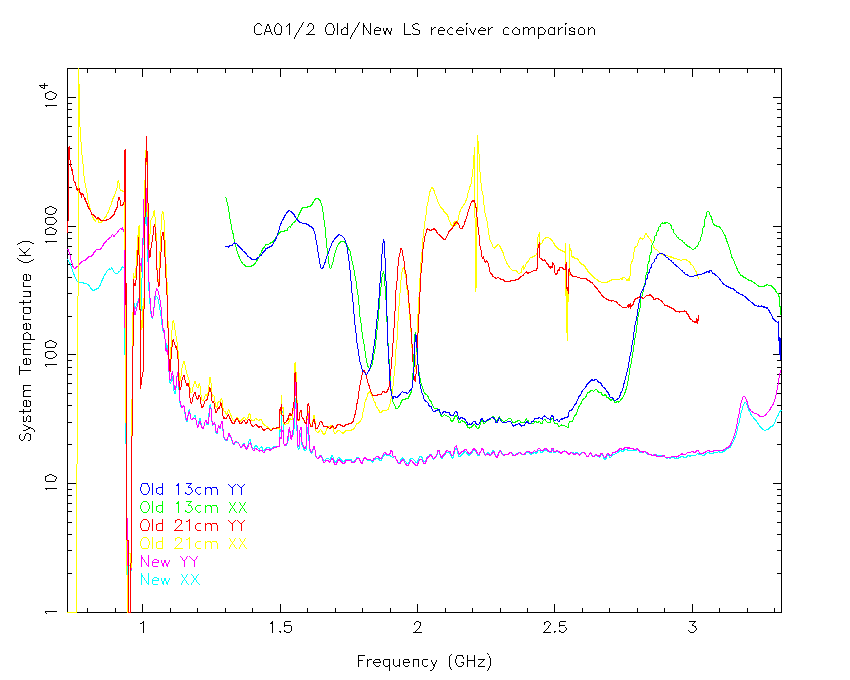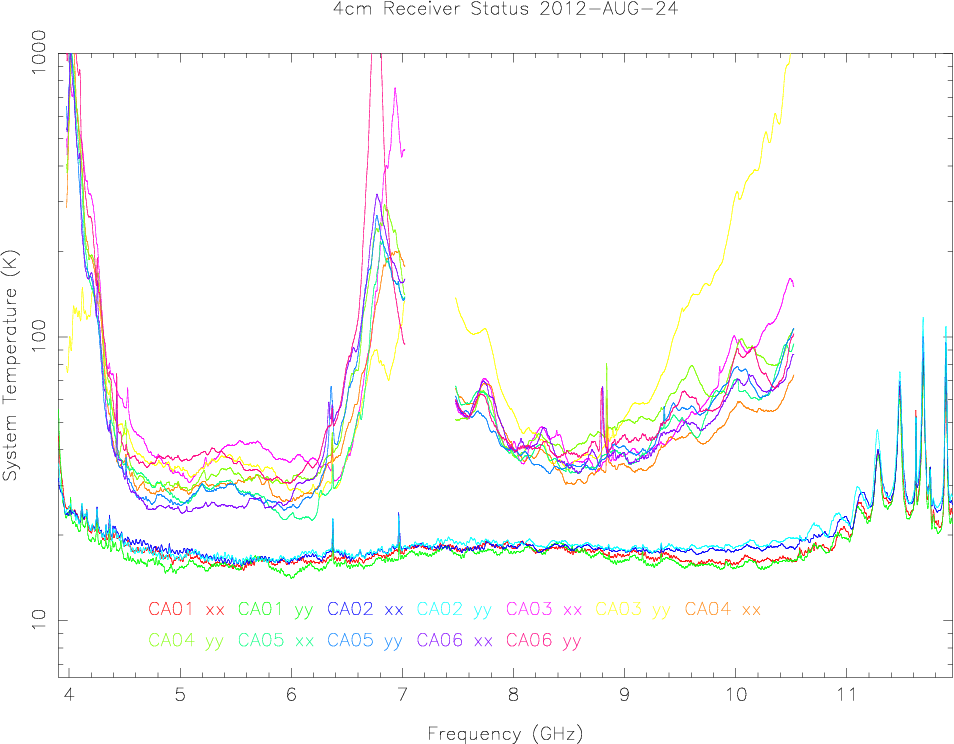ATCA Issue Log
ATCA Mosaics
Several ATCA programs to mosaic large fields have been affected by a mosaic field name length bug that existed until May 2012. Until that time CABB would only read the first 8 characters of the mosaic field name when setting the phase centre position. This means that, e.g., a field named fornax_70 would be truncated to fornax_7 and so the field would be observed with the phase centre of field fornax_7. The antennas are pointing in the correct position, so no sensitivity has been lost, it is just the phase centre and axis labelling which are wrong. The best way to recover the data is to first image all the fields individually, then fix the headers (with puthd) to put in the actual phase centre position (so, for the eaxmple above to put in the fornax_7 position for the fornax_70 fields). After all images have the correct header, it is possible to run linmos and all should be well, since invert stores the pointing position in a mosaic table in each image. The only residual effects should be time and bandwidth smearing, which would be based on the actual phase centre positions used. If the fields are a long way away from from this, point sources may become somewhat extended due to these effects.
Phase jumps
For several years there have been reports of occasional phase jumps on all baselines to one antenna. The first report of this issue was in August 2011, baselines to CA03, and was followed by another fault report in Nov 2012. Phase jumps started being noticed more regularly in 2014 and 2015. This problem, due to its intermittent nature, took a long time to track down, and was finally resolved after a process of moving electronics units between antennas to see isolate the problem. In summary: From August 2011 to December 2012: infrequent instances of phase jumps on baselines to CA03. From some around late 2013/early 2014, phase jumps were seen on baselines to CA04. From 13 Jun 2014 to 17 Nov 2014: CA06 has occasional phase jumps. From 27 Nov 2014 to 17 Apr 2015: CA03 has occasional phase jumps. From 17 Apr 2015 to sometime in May/June: CA05 has occasional phase jumps. Form sometime in May/June to 1 Jul 2015: CA02 has occasional phase jumps. From 1 Jul to 9 Jul 2015: CA04 has the phase jumps. From 9 Jul 2015 the problem appears to have been fixed. For data affected by phase jumps, the following data reduction is recommended: calibrate the data as usual. If a phase jump occurs during a scan on a phase calibrator, there isn't a problem. If it occurs on the target source, then there will be some decorrelation due to the incorrect phase interpolation between calibrator scans. The try making an image without the affected antenna. If there is a strong enough source in the field, do a selfcal on the entire dataset, and this should get rid of the problem. If not, and it is suspected that there is a problem, look at the phase solutions for the problem antenna, and discard that data which might have been affected by the jump. While this process is manual and time consuming, it is relatively straightforward.
Corrupt first cycle in CABB zoom modes
Until 23-apr-2014, a problem existed with CABB zoom modes, where the first cycle of any scan may have been corrupted. A more complete description of the problem can be found in a post on the ATCA Forum.
LO Problem at 7mm
Between 07-apr-2011 and 02-dec-2013, there was a bug in the algorithm used to set the central site synthesiser for sky frequencies between 30 and 50 GHz. For observations made in the 7mm band between these dates, there is a chance that the observed central frequencies may be offset by +/- 1 kHz from the nominated central frequency. This will be most important for observers using the CABB 1 MHz zoom bands, but may also affect other spectral-line observations. A post that describes this problem in more detail can be found on the ATCA Forum.
ATCA Millimetre Baseline Corrections
After an array reconfiguration, antenna pointing and baseline solutions are determined from observations at 6cm. For various reasons, this baseline solution is sometimes not optimal for 3mm, 7mm and 15mm. Unless you can self-calibrate on your source, you will find phase errors resulting from use of the default (6cm) antenna positions, which are especially severe at 3mm. This page lists updates to the baseline solution produced by deriving baseline solutions at 15mm on those occasions this was necessary, and gives instructions for reading this into miriad.
CA01 Bandpass Ripple
For a year or so until 18-sep-2013, there was a bandpass ripple affecting Y-pol on CA01 that was most noticable in the 5.5 GHz band. This was finally tracked down to a faulty cable which was replaced. For more details on this problem please visit the ATCA Forum.
High Tsys on CA06 3cm-A pol
In 2011, the system temperature on the A-pol of the 3cm receiver on CA06 was about twice that of other receivers (and the B-pol on CA06). This was remedied when the old 3cm/6cm receivers were replaced by the new 4cm receiver in 2012.
7mm polarization data
If you have processed 7mm polarization observations with a Miriad version older than 4 Mar 2010, the polarization angles will be off by 90 degrees. Loading 7mm data with a more recent version of Miriad will automatically correct this issue.
Jan 2009 Leap Second Problems
A leap second was added to UTC at UT 00:00 on 1 January 2009, and, until the intricacies of ATCA ephemeris handling were resolved, there was a 1 second timing error in data observed between UT 00:00 on 1 January 2009 and 13 January 2009). The error is not substantial, and it might be that it will not be noticeable for low frequency observations. However the effect becomes more significant at higher frequencies. To correct the data use miriad "uvedit": uvedit time=-1 vis=in-file out=out-file. This corrects the input data-set "in-file", and produces output "out-file". You should do this before any calibration.
Accidental online selfcal in CAOBS
In a small number of observations between April 2007 and September 2008, the selfcal function in CAOBS (developed as part of the array's satellite tracking capability) was inadvertently switched on. We have identified these occurrences and notified affected observers. To restore the phases in data with selfcal switched on in CAOBS see this link.
Positions in ATCA calibrator database
It appears the ATCA calibrator database had, for some period, positions for a small number of sources that were in error by several arcseconds. These sources include 0420-625 (which was listed [J2000] as RA=04:20:55.33, Dec=-62:23:39.70 instead of RA=04:20:56.13, Dec=-62:23:38.70), and 2323-407 (which has an AT20G and ATPMN position of RA=23:26:34.1, Dec=-40:27:17.7). If reducing archival data it is always a good idea to double check the positions of calibrator sources, as improved determinations may since have become available.
On-line log of issues for 2004 and 2005
If you are reducing archival data taken in 2004JAN or 2004MAY terms or 2004OCT or 2005APR semesters, it may be worth checking the on-line log of issues maintained for those periods.
Wideband Receiver Installation dates
To make effective use of CABB's wider bandwidths, the old 20/13cm and 6/3cm receivers were replaced with the improved 16cm and 4cm receivers respectively. This happened over a period of a couple of years. The following table lists when the new receivers were installed on each of the ATCA antennas.
| Antenna | 16cm Installed | 4cm Installed |
|---|---|---|
| CA01 | 2010-Dec-06 | 2012-Aug-21 |
| CA02 | 2010-Jun-21 | 2011-Nov-29 |
| CA03 | 2009-Nov-02 | 2012-Sep-18 |
| CA04 | 2010-Aug-16 | 2013-Feb-19 |
| CA05 | 2010-Oct-18 | 2012-Nov-26 |
| CA06 | 2010-Aug-16 | 2012-Nov-27 |
To illustrate the improvement in usable bandwidth that the new receivers enabled, look at the following plots. In this first plot, a comparison is shown between the system temperatures of the old 20cm and 13cm receivers and the new 16cm receiver. In general, CABB would only use the 20cm receivers before the upgrade, because demand for the 13cm frequencies was lower.

In the second plot, a comparison is shown between the system temperatures of the old 6/3cm receivers and the new 4cm receivers. Although the old 6/3cm receivers could take advantage of the 2 GHz of bandwidth CABB provided in each IF, the sensitivity of those bands was poor towards the edges.

Last modified: Jamie Stevens (02-dec-2015)
